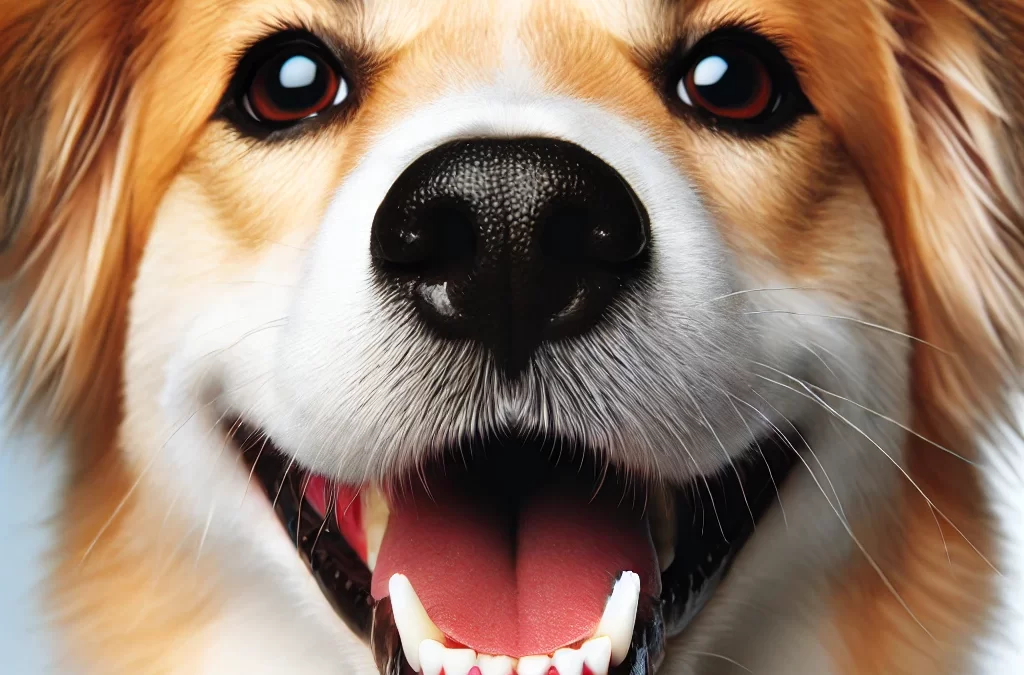
by TCMVET | Aug 28, 2024 | Dog Cancer & Tumors
Tracheal tumors in dogs, while rare, can pose significant health challenges. These tumors may arise from various tissues within or surrounding the trachea, leading to a variety of symptoms and necessitating specific treatment approaches. Understanding the types of tracheal tumors, their symptoms, and the treatment options available is crucial for dog owners to ensure the best care for their pets.
Common Types of Tracheal Tumors in Dogs
Tracheal tumors in dogs can be classified as either benign or malignant, with each type presenting different implications for the dog’s health.
- Chondromas, Osteomas, and Osteochondromas: These are the most common types of benign tracheal tumors in dogs. Chondromas originate from cartilage, while osteomas arise from bone tissue. Osteochondromas involve both bone and cartilage and are particularly prevalent in younger dogs, sometimes occurring in those less than a year old. Fortunately, these benign tumors often have a good prognosis when surgically removed.
- Leiomyomas and Polyps: Leiomyomas are benign smooth muscle tumors, and polyps are non-cancerous growths that can develop in the tracheal region. Both types of tumors generally have a favorable outcome when treated appropriately.
- Malignant Tracheal Tumors: Although less common, malignant tumors in the trachea can be severe. These include plasmacytomas, osteosarcomas (OSA), chondrosarcomas (CSA), mast cell tumors (MCT), lymphosarcomas (LSA), squamous cell carcinomas (SCC), and rhabdomyosarcomas. Each type requires different treatment strategies, with surgical removal, chemotherapy, and radiation therapy being potential options.
Symptoms of Tracheal Tumors in Dogs
The symptoms of tracheal tumors can vary depending on the tumor’s size, location, and whether it is benign or malignant. Some of the most common clinical signs include:
- Difficulty Breathing: Dogs with tracheal tumors often experience respiratory distress, which may manifest as difficulty breathing, wheezing, or stridor (a high-pitched wheezing sound).
- Coughing: A persistent cough is another common symptom, often accompanied by wheezing and labored breathing.
- Swallowing Difficulties: In some cases, especially when the tumor is located near the throat, dogs may have trouble swallowing, which can lead to weight loss and malnutrition.
- Voice Changes: Tumors in the laryngeal or pharyngeal regions may affect a dog’s voice, causing it to sound hoarse or altered.
- Palpable Mass: In some instances, a mass may be felt in the neck or throat area, indicating the presence of a tumor.
These symptoms can be exacerbated by factors such as excitement, stress, high temperatures, or physical activity. Notably, cats tend to tolerate tracheal tumors better than dogs, as they are less prone to overexertion or excitement, which can worsen symptoms.
Treatment Options for Tracheal Tumors in Dogs
The treatment of tracheal tumors in dogs depends on several factors, including the type and location of the tumor, the dog’s overall health, and whether the tumor is benign or malignant.
- Surgical Removal: Surgery is often the first line of treatment, especially for benign tumors like chondromas and osteochondromas. When the tumor is localized and accessible, surgical excision can be curative.
- Chemotherapy: For malignant tumors, chemotherapy may be recommended either as a standalone treatment or in conjunction with surgery. Chemotherapy is particularly useful for systemic cancers like lymphosarcoma, which often affects multiple areas of the body.
- Radiation Therapy: Radiation may be employed to shrink tumors or manage symptoms, especially when surgery is not a viable option. It is commonly used for treating squamous cell carcinoma and other malignancies that are difficult to remove surgically.
- Palliative Care: In cases where curative treatment is not possible, palliative care focuses on relieving symptoms and improving the quality of life for the dog. This may involve medications to reduce pain and inflammation, as well as therapies to ease breathing difficulties.
Early detection and treatment are critical for managing tracheal tumors effectively. Regular veterinary check-ups and prompt attention to any signs of respiratory distress or abnormal growths can greatly improve the prognosis for dogs with tracheal tumors.

by TCMVET | Aug 25, 2024 | Dog Cancer & Tumors
Gingival tumors in dogs can be a concerning diagnosis for any pet owner. These growths, which can range from benign to malignant, often lead to discomfort, difficulty eating, and, in severe cases, significant health complications. While conventional treatments like surgery and chemotherapy are the go-to solutions, many pet owners are now exploring natural therapies as a complementary approach. In this article, we’ll dive into the role of natural therapies in managing canine gingival tumors and highlight the benefits of TCMVET Baituxiao, a promising herbal formula that aligns with traditional Chinese veterinary medicine (TCVM).
Understanding Canine Gingival Tumors
Canine gingival tumors can manifest as lumps or abnormal tissue growths on the gums. Some of these tumors are benign, such as epulides, while others can be malignant, like melanomas or squamous cell carcinomas. Regardless of the type, early detection and proactive management are key in improving outcomes.
The Role of Natural Therapies
Natural therapies focus on supporting the body’s innate healing processes, reducing inflammation, and improving overall well-being. For gingival tumors, natural treatments aim to:
- Reduce Tumor Growth: Certain herbs and supplements may help slow the proliferation of abnormal cells.
- Strengthen the Immune System: A robust immune system is crucial for controlling tumor growth and preventing metastasis.
- Improve Quality of Life: Natural remedies can ease discomfort, reduce pain, and support overall vitality, especially in older dogs.
TCMVET Baituxiao: A Holistic Herbal Approach
One of the key natural therapies gaining attention is TCMVET Baituxiao, a blend of traditional Chinese herbs designed to address masses and lumps, particularly in the context of tumor management. Based on the principles of traditional Chinese veterinary medicine, TCMVET Baituxiao is formulated to:
- Disperse Stagnation: According to TCVM, tumors are often the result of stagnant energy (Qi) and blood. Baituxiao contains herbs that help disperse these blockages, promoting better energy flow and reducing the size of growths.
- Reduce Inflammation and Swelling: The anti-inflammatory properties of the herbs in Baituxiao can help alleviate discomfort and swelling associated with gingival tumors.
- Boost the Immune System: A strong immune system is essential in controlling tumor growth. Baituxiao includes herbs known to enhance immune function, helping the body naturally combat abnormal cell proliferation.
- Support Overall Vitality: Baituxiao’s holistic formulation not only targets the tumor but also promotes overall health, ensuring your dog maintains energy and a good quality of life during treatment.
Integrating Natural Therapies with Conventional Treatment
While natural therapies can be effective, they work best when integrated with conventional treatments. For example, TCMVET Baituxiao can be used alongside surgery or radiation therapy to support recovery and enhance outcomes. It’s important to consult with your vet before starting any new treatment, especially when dealing with tumors.
Additional Natural Therapies to Consider
In addition to TCMVET Baituxiao, other natural therapies may help manage canine gingival tumors:
- Dietary Changes: Feeding your dog a diet rich in antioxidants, omega-3 fatty acids, and anti-inflammatory foods can support the immune system and reduce inflammation.
- Herbal Supplements: Herbs like turmeric, milk thistle, and reishi mushrooms are known for their anti-cancer properties and can be included in your dog’s diet.
- Acupuncture: Acupuncture, another component of TCVM, can help relieve pain and improve energy flow, which is particularly useful for dogs with advanced tumors.
- Homeopathy: Some pet owners find success using homeopathic remedies that focus on balancing the body’s natural energy and targeting specific tumor types.
The Importance of Early and Consistent Care
For dogs diagnosed with gingival tumors, early intervention is crucial. By incorporating a holistic approach that combines conventional treatment with natural therapies like TCMVET Baituxiao, you can give your dog the best chance at a positive outcome. Regular check-ups, dental care, and consistent monitoring are essential in managing this condition.
Conclusion: A Balanced Approach to Tumor Care
Canine gingival tumors are a serious health concern, but they don’t have to be a death sentence. By integrating natural therapies into your dog’s treatment plan, you can provide additional support that not only targets the tumor but also enhances overall health. TCMVET Baituxiao stands out as a natural, holistic option for dogs facing this challenge, offering hope for pet owners seeking a more balanced and less invasive path to care.
Ultimately, every dog is unique, and finding the right combination of therapies requires careful consideration and consultation with your vet. With the right approach, you can ensure your dog’s journey through this condition is as comfortable and positive as possible.

by TCMVET | Aug 25, 2024 | Dog Cancer & Tumors
When it comes to canine oral health, most pet owners think of plaque, tartar, and the importance of brushing. But a lesser-known issue that can silently impact your dog’s well-being is gingival tumors. These growths, often overlooked, can range from benign to malignant and have a significant impact on a dog’s quality of life.
What Are Canine Gingival Tumors?
Canine gingival tumors are growths that develop on the gums or surrounding areas in a dog’s mouth. They can appear as small nodules or larger, noticeable lumps, often resembling a piece of extra gum tissue. While these tumors can occur in any breed, older dogs and certain breeds like Boxers and Golden Retrievers are more predisposed.
Types of Gingival Tumors in Dogs
Understanding the nature of the tumor is crucial for determining the appropriate treatment. Canine gingival tumors are categorized into three main types:
- Epulides (Benign Tumors): These are the most common type of gingival tumors and are usually non-cancerous. Epulides can be fibromatous, ossifying, or acanthomatous. While benign, they can cause discomfort if they grow large enough to affect eating or chewing.
- Malignant Melanomas: These are aggressive and have a high chance of spreading (metastasis). Melanomas often start in the gums or the tissues around the mouth and can rapidly become life-threatening if not treated.
- Squamous Cell Carcinomas: These tumors are also malignant but are less likely to spread than melanomas. However, they can be locally invasive, destroying bone and other tissues.
Symptoms: What to Watch For
Spotting a gingival tumor early can be tricky. Here are key signs to look out for:
- Unusual lumps or growths on the gums.
- Bad breath that persists even with regular cleaning.
- Difficulty chewing or reluctance to eat harder foods.
- Bleeding from the mouth or blood in the saliva.
- Loose teeth not associated with aging or dental disease.
If you notice any of these symptoms, a prompt visit to the vet is essential for a diagnosis.
Diagnosis and Treatment: What’s Next?
Diagnosis usually involves a biopsy, where a small portion of the growth is examined under a microscope. Imaging, such as X-rays, may be needed to assess if the tumor has affected surrounding tissues or bones.
Treatment Options:
- Surgical Removal: For benign tumors, surgical removal is often curative. However, in the case of malignant tumors, more aggressive surgery might be needed.
- Radiation Therapy: This is commonly used for tumors that are difficult to remove completely or those that are malignant.
- Chemotherapy: While less common for gingival tumors, it might be recommended if the cancer has spread.
- Innovative Therapies: In recent years, there’s been growing interest in natural supplements and integrative therapies that could support conventional treatment. For example, certain herbal formulations have shown promise in helping to manage inflammation and boost the immune system, providing additional support for dogs undergoing conventional cancer treatments.
The Importance of Early Detection
One of the most effective ways to manage canine gingival tumors is through early detection. Regular dental check-ups not only prevent dental disease but also allow vets to catch any unusual growths early on. As a pet owner, getting into the habit of checking your dog’s mouth for abnormalities can make a huge difference.
Prevention and Maintenance: A Holistic Approach
While some tumors are unavoidable due to genetics, maintaining overall oral health can lower the risk. Regular brushing, using dental chews, and providing a balanced diet rich in antioxidants can play a role in keeping the gums healthy. Additionally, some pet owners are exploring natural supplements that claim to promote oral health by reducing inflammation and supporting the immune system.
Final Thoughts: Stay Informed and Proactive
Canine gingival tumors may seem like a minor issue at first glance, but they can lead to significant complications if left unchecked. By staying informed and proactive, you can catch problems early and ensure that your dog gets the best care possible. While this topic may not be as widely discussed as other canine health issues, being aware of it could make all the difference for your furry friend.
Remember, every dog deserves a happy, healthy smile—and a little attention to oral health can go a long way in achieving that!

by TCMVET | Aug 21, 2024 | Dog Cancer & Tumors
Caring for a dog undergoing cancer treatment involves more than just medical interventions. Adjusting their environment and lifestyle can significantly impact their recovery and overall well-being. This article explores how reducing exposure to environmental toxins, increasing physical activity, and minimizing stress can contribute to a healthier, more supportive environment for dogs battling cancer.
Reducing Exposure to Environmental Toxins
One of the most crucial steps in supporting a dog with cancer is minimizing their exposure to harmful chemicals and toxins. Here’s how you can create a cleaner, safer living environment for your pet:
- Avoid Chemical Cleaners: Switch to natural, non-toxic cleaning products in your home. Chemical cleaners can release harmful fumes and residues that your dog might inhale or ingest. Opt for eco-friendly alternatives that are safe for both pets and humans.
- Limit Pesticide Exposure: Keep your dog away from areas that have been treated with pesticides or herbicides. These chemicals can be harmful, especially to dogs with compromised immune systems. Consider using natural pest control methods in your garden or yard.
- Choose Safe Pet Products: Be mindful of the products you use on your dog, such as shampoos, flea treatments, and grooming products. Select items that are free from harsh chemicals and are specifically formulated for pets with sensitive health needs.
Increasing Exercise and Activity
Physical activity is vital for maintaining your dog’s health, especially during cancer treatment. Regular exercise offers numerous benefits:
- Boosting Immunity: Exercise helps to strengthen your dog’s immune system, making them more resilient against illness. Even light activity, like walking or gentle play, can have a positive impact on their health.
- Enhancing Physical Strength: Maintaining physical strength is important for dogs undergoing cancer treatment. Exercise helps to preserve muscle mass, improve circulation, and support overall vitality.
- Improving Mental Health: Regular activity can alleviate symptoms of depression or anxiety in dogs, providing them with mental stimulation and a sense of normalcy. This is especially important during the stress of treatment.
Minimizing Stress for Better Recovery
Creating a low-stress environment is essential for dogs dealing with cancer. Stress can negatively affect their immune system and slow down recovery. Here are some strategies to help keep your dog calm and relaxed:
- Provide Consistent Routine: Dogs thrive on routine. Maintaining a consistent daily schedule for feeding, walks, and rest helps reduce anxiety and provides a sense of stability.
- Incorporate Relaxation Techniques: Regularly petting, gentle brushing, and massage can help your dog relax and reduce stress. These activities not only soothe your dog but also strengthen your bond with them.
- Create a Peaceful Environment: Ensure your dog has a quiet, comfortable space where they can rest undisturbed. This environment should be free from loud noises, excessive foot traffic, and other stressors.
Supporting a dog through cancer treatment involves more than just medical care. By reducing exposure to environmental toxins, increasing exercise, and minimizing stress, you can create a healthier and more nurturing environment that promotes recovery and well-being. These lifestyle adjustments can make a significant difference in your dog’s quality of life during this challenging time.

by TCMVET | Aug 21, 2024 | Dog Cancer & Tumors
Supporting your pet’s overall health goes beyond just diet and exercise. Integrative therapies like acupuncture and massage therapy can play a crucial role in promoting wellness, particularly for pets dealing with chronic conditions, pain, or the side effects of treatments like chemotherapy. This article explores how acupuncture and massage therapy can benefit your pet’s health and enhance their quality of life.
The Role of Acupuncture in Pet Health
Acupuncture, a practice rooted in traditional Chinese medicine, involves the insertion of thin needles into specific points on the body. This therapy is known for its ability to balance the body’s energy (Qi) and promote healing. For pets, acupuncture can offer several significant benefits:
- Pain Relief: Acupuncture is particularly effective in managing pain, especially in pets suffering from arthritis, hip dysplasia, or chronic pain conditions. By stimulating the nervous system, acupuncture can release endorphins, the body’s natural painkillers, providing relief without the side effects of medication.
- Reducing Chemotherapy Side Effects: Pets undergoing chemotherapy often experience side effects such as nausea, fatigue, and loss of appetite. Acupuncture can help alleviate these symptoms, making the treatment process more tolerable and improving the pet’s overall well-being.
- Supporting Overall Health: Beyond pain management, acupuncture helps in improving circulation, reducing inflammation, and boosting the immune system. These benefits contribute to a pet’s overall health and vitality, making it a valuable tool in holistic pet care.
The Benefits of Massage Therapy for Pets
Massage therapy, much like in humans, can significantly enhance a pet’s physical and emotional well-being. Regular massage sessions can provide the following benefits:
- Pain and Discomfort Reduction: Massage therapy helps to relieve pain and discomfort by easing muscle tension and promoting relaxation. This is particularly beneficial for pets with conditions like arthritis, muscle injuries, or those recovering from surgery.
- Improved Circulation: Massage stimulates blood flow, which is essential for delivering nutrients and oxygen to tissues and removing toxins. Improved circulation supports faster healing and maintains muscle and joint health.
- Stress and Anxiety Relief: Regular massage can help reduce stress and anxiety in pets, leading to a calmer and more relaxed demeanor. This is particularly useful for pets with behavioral issues or those experiencing anxiety due to illness or environmental changes.
- Enhanced Bonding: Massage sessions provide an excellent opportunity for pet owners to bond with their pets, strengthening the emotional connection and trust between them.
Integrating Acupuncture and Massage into Your Pet’s Care Routine
Incorporating acupuncture and massage therapy into your pet’s care routine can provide a comprehensive approach to wellness. These therapies are not just about treating specific conditions; they focus on maintaining overall health, preventing future issues, and improving the quality of life for your pet. It is important to work with qualified professionals who specialize in animal acupuncture and massage to ensure your pet receives the best care.
Acupuncture and massage therapy offer a holistic approach to enhancing your pet’s health and well-being. By addressing pain, reducing stress, and supporting overall health, these therapies can significantly improve your pet’s quality of life. Whether your pet is dealing with a chronic condition or you simply want to enhance their wellness, these integrative therapies are worth considering.

by TCMVET | Aug 18, 2024 | Dog Cancer & Tumors
Lymphoma is one of the most common cancers affecting dogs, particularly older ones. While traditional treatments like chemotherapy are often necessary, many pet owners are turning to natural remedies to complement these treatments. Self-Heal, also known as Xia Ku Cao in Traditional Chinese Medicine (TCM), is one such herb gaining attention for its potential benefits in supporting canine lymphoma treatment. This article explores how Self-Heal can be used as an adjunct therapy for dogs battling lymphoma.
Understanding Canine Lymphoma
Canine lymphoma is a type of cancer that originates in the lymphocytes, a type of white blood cell that plays a crucial role in the immune system. This cancer can manifest in various forms, affecting the lymph nodes, spleen, liver, and other organs. Symptoms often include swollen lymph nodes, lethargy, weight loss, and loss of appetite. Early diagnosis and treatment are essential for managing the disease.
The Role of Self-Heal (Xia Ku Cao) in Lymphoma Treatment
Self-Heal (Prunella vulgaris), or Xia Ku Cao in TCM, is a herb traditionally used for its anti-inflammatory, immune-boosting, and anti-tumor properties. While it is not a cure for lymphoma, Self-Heal can be used to support conventional treatments, potentially enhancing their effectiveness and improving the dog’s quality of life.
Immune System Support
One of the most significant benefits of Self-Heal is its ability to support the immune system. In dogs undergoing chemotherapy for lymphoma, the immune system can become compromised, making the body more susceptible to infections and slower to heal. Self-Heal’s immune-boosting properties help strengthen the dog’s natural defenses, providing additional support during the taxing chemotherapy process.
Anti-Inflammatory and Antioxidant Effects
Lymphoma often causes inflammation in the affected organs and tissues, leading to discomfort and further health complications. Self-Heal has potent anti-inflammatory properties that can help reduce this inflammation, potentially easing pain and discomfort in dogs with lymphoma. Additionally, its antioxidant effects help combat oxidative stress, a condition that can exacerbate cancer and other chronic diseases.
Potential Anti-Tumor Properties
While more research is needed, some studies suggest that Self-Heal may have anti-tumor properties, which could make it beneficial in the treatment of cancers like lymphoma. The herb has been shown to inhibit the growth of certain cancer cells in laboratory studies. When used as part of a holistic treatment plan, Self-Heal may help slow the progression of lymphoma and support overall health.
How to Incorporate Self-Heal into Your Dog’s Treatment Plan
Self-Heal can be administered to dogs in several forms:
- Tinctures: A liquid extract of Self-Heal can be added to your dog’s food or water.
- Capsules: Self-Heal capsules can be given directly or mixed with food.
- Herbal Teas: Brew Self-Heal into a mild tea and add it to your dog’s water for a more natural approach.
It’s crucial to consult with a veterinarian experienced in herbal medicine to determine the correct dosage and method of administration for your dog’s specific condition. The use of Self-Heal should complement, not replace, traditional cancer treatments like chemotherapy.
Safety and Considerations
While Self-Heal is generally safe for dogs, it should always be used under veterinary supervision, especially when dealing with a serious condition like lymphoma. Overuse or incorrect dosing can lead to side effects. Additionally, ensure that the Self-Heal products you use are of high quality and free from contaminants.
Self-Heal (Xia Ku Cao) offers a natural way to support the treatment of canine lymphoma, particularly in boosting the immune system, reducing inflammation, and potentially inhibiting tumor growth. As an adjunct therapy, it can enhance the effectiveness of traditional treatments and improve the overall well-being of dogs battling lymphoma. Always work closely with your veterinarian to ensure the safe and effective use of herbal remedies in your dog’s treatment plan.






